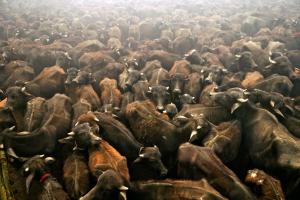Devotees slaughter tens of thousands of animals in Nepal festival
More than two million Hindus massed in a remote corner of Nepal on Friday for the slaughter of tens of thousands of animals to honour a goddess, defying protests from rights activists.
Devotees turned the village of Bariyapur and its surrounding fields near the Indian border into the world's largest abattoir for the two-day festival with animals ranging from buffaloes to rats sacrificed.
Parents and their children along with the elderly poured into the village, which resembled a carnival with stalls selling balloons, sweets, toys and religious paraphernalia.
"It has been a grand day," said head priest Mangal Chaudhary near a temple devoted to the Hindu goddess of power Gadhimai.
"The buffalo sacrifice has ended, but we will continue the rituals with goats and other animals for one more day," Chaudhary told AFP.
Animal carcasses and severed heads were piling up in the large fields where many devotees were handing over their animals to butchers and others to carry out the sacrifices, eyewitnesses told AFP.
"It is very bloody... you can hear the animals moaning," said Rameshwor Mehta, 50, who was waiting to offer his prayers.
About 2.5 million devotees -- arriving by bus, tractor and other vehicles -- have turned out for the festival, according to local government official Yogendra Prasad Dulal, who said it was "impossible to estimate" the total number of animals sacrificed so far.
Worshippers on the first day slaughtered more than 6,000 buffaloes, which were coralled into holding pens in the fields, along with at least 100,000 goats and other animals, head priest Chaudhary told AFP.
Sita Ram Yadav, a 55-year-old farmer who had travelled three hours to attend the festival, said the atmosphere was "like a carnival".
"I am offering a goat to Gadhimai to keep my family safe. If you believe in her, she grants your wishes," Yadav told AFP.
Worshippers from Nepal and neighbouring India have spent days sleeping out in the open and offering prayers to the goddess at a temple decked with flowers in preparation.
- Stench of meat -
The festival kicked off at midnight Thursday, with the ceremonial killing of a goat, rat, chicken, pig and a pigeon.
Some 1,200 police personnel were patrolling the village and the fields where sacrifices were taking place to control the crowds gathered to watch, a police officer told AFP.
Excited devotees attempted to scale a five-foot high (1.5 metre) wall erected around the slaughter sites, while police worked to keep the area clear and avert possible clashes between worshippers and activists.
An estimated 300,000 animals had their heads chopped off or throats slit during the last festival in 2009, making it the world's biggest sacrifice of animals at any one site.
The spectacle leaves pools of blood across the temple grounds, the air thick with the stench of raw meat.
Authorities eventually dump buffaloes' heads into a large, freshly dug pit. The goat and chicken meat is distributed to devotees and villagers, while contractors bid to buy the buffalo and animal hides.
"Even after the bodies are taken away, the smell remains, forcing us to cover our mouth and nose... it is definitely a threat to our health," said Utim Lal Chaurasiya, who lives near the village.
"The devotees come from outside, celebrate and leave. It is local people who suffer the aftermath," the social worker, 36, told AFP.
According to legend, the first sacrifices in Bariyapur were conducted several centuries ago when Gadhimai appeared to a prisoner in a dream and asked him to establish a temple to her.
When he awoke, his shackles had fallen open and he was able to leave the prison and build the temple, where he sacrificed animals to give thanks.
A campaign to ban the festival has attracted support from celebrities including British actress Joanna Lumley and French movie legend Brigitte Bardot, who has petitioned Nepal's president to end the "cruel tradition".




No comments:
Post a Comment